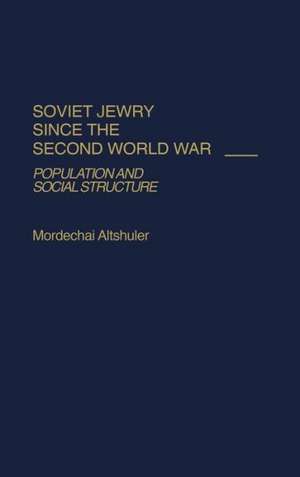Soviet Jewry Since the Second World War: Population and Social Structure: Bibliographies and Indexes in Women's Studies, cartea 5
Autor Mordechai Altshuleren Limba Engleză Hardback – 31 mar 1987
In the past two decades much attention has been focused on two major issues facing Soviet Jews: their struggle to emigrate and their efforts to practice their religion and culture within the Soviet Union. Altshuler's study provides the statistical background necessary to understand the characteristics of this Jewish population, including its occupational structure, patterns of residence, and membership in the Communist Party. He also provides important data illuminating issues of family composition and intermarriage.
Preț: 464.32 lei
Preț vechi: 709.07 lei
-35% Nou
Puncte Express: 696
Preț estimativ în valută:
88.85€ • 93.08$ • 73.64£
88.85€ • 93.08$ • 73.64£
Carte tipărită la comandă
Livrare economică 09-23 aprilie
Preluare comenzi: 021 569.72.76
Specificații
ISBN-13: 9780313244940
ISBN-10: 0313244944
Pagini: 296
Dimensiuni: 163 x 244 x 27 mm
Greutate: 0.64 kg
Editura: Praeger
Seria Bibliographies and Indexes in Women's Studies
ISBN-10: 0313244944
Pagini: 296
Dimensiuni: 163 x 244 x 27 mm
Greutate: 0.64 kg
Editura: Praeger
Seria Bibliographies and Indexes in Women's Studies
Cuprins
Preface
Historical Background and Methodological Problems
Fundamental Issues in Determining the Size of the Jewish Population in the Soviet Union
The Geographic Distribution of Soviet Jewry
Distribution of Soviet Jews by Sex and Internal Migration
Education
Social Stratification and Economic Activity
Language and Nationality
Jews in the Communist Party and the Soviets
Conclusion
Selected Bibliography
Index
Historical Background and Methodological Problems
Fundamental Issues in Determining the Size of the Jewish Population in the Soviet Union
The Geographic Distribution of Soviet Jewry
Distribution of Soviet Jews by Sex and Internal Migration
Education
Social Stratification and Economic Activity
Language and Nationality
Jews in the Communist Party and the Soviets
Conclusion
Selected Bibliography
Index
Recenzii
«Altshuler has written a valuable sourcebook on the social and demographic developments within Soviet Jewry since WW II. He reports that the Jewish national minority is the only entirely urban Soviet ethnic group, and that the number of Soviet Jews has declined because of the Holocaust assimilation, and emigration. Altshuler also finds that significant numbers of Jews (relative to their percentage of the total Soviet population) tend to be highly educated and hold important jobs in science, medicine, and higher education. In these ways, the sociodemographic profile of Soviet Jewry parallels that of Jewish groups in other developed countries rather than that of other national groups in the USSR. The author also points out that a fairly large number of Jews belong to the Communist party for reasons of ideology, career opportunities, or inertia. The percentage of Jews tied to the party--nearly 15%--far exceeds that of any other Soviet national group. The Jews also account for close to 2% of party members and candidates, more than double their proportion of the population. On the other hand, anti-Jewish discrimination remains strong throughout the Soviet Union. The book is well documented and contains important demographic tables and graphs. It is especially recommended for libraries with strong collections of Soviet and East European materials.“”Choice
Notă biografică
MORDECHAI ALTSHULER of the Institute of Contemporary Jewry of the Hebrew University of Jerusalem is a recognized expert on Soviet Jewry.
























